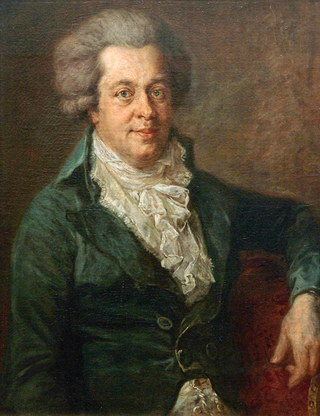Related Research Articles
A concerto is, from the late Baroque era, mostly understood as an instrumental composition, written for one or more soloists accompanied by an orchestra or other ensemble. The typical three-movement structure, a slow movement preceded and followed by fast movements, became a standard from the early 18th century.

Carl Philipp Stamitz was a German composer of partial Czech ancestry. He was the most prominent representative of the second generation of the Mannheim School.

A piano concerto, a type of concerto, is a solo composition in the classical music genre which is composed for piano accompanied by an orchestra or other large ensemble. Piano concertos are typically virtuosic showpieces which require an advanced level of technique. Piano concertos are typically written out in music notation, including sheet music for the pianist, orchestral parts, and a full score for the conductor.

The Bassoon Concerto in B-flat major, K. 191/186e, is a bassoon concerto written in 1774 by Wolfgang Amadeus Mozart. It is the most often performed and studied piece in the entire bassoon repertory. Nearly all professional bassoonists will perform the piece at some stage in their career, and it is probably the most commonly requested piece in orchestral auditions – it is usually requested that the player perform excerpts from the concerto's first two movements in every audition.

The Symphony No. 38 in D major, K. 504, was composed by Wolfgang Amadeus Mozart in late 1786. It premiered in Prague on January 19, 1787, during Mozart's first visit to the city. Because it was first performed in Prague, it is popularly known as the Prague Symphony. Mozart's autograph thematic catalogue records December 6, 1786, as the date of completion for this composition.

Robert David Levin is an American classical pianist, musicologist, and composer who served as the artistic director of the Sarasota Music Festival from 2007 to 2017.

The Piano Concerto No. 24 in C minor, K. 491, is a concerto composed by Wolfgang Amadeus Mozart for keyboard and orchestra. Mozart composed the concerto in the winter of 1785–1786, finishing it on 24 March 1786, three weeks after completing his Piano Concerto No. 23 in A major. As he intended to perform the work himself, Mozart did not write out the soloist's part in full. The premiere was in early April 1786 at the Burgtheater in Vienna. Chronologically, the work is the twentieth of Mozart's 23 original piano concertos.

Wolfgang Amadeus Mozart's Piano Concerto No. 9 in E♭ major, K. 271, known as the Jeunehomme or Jenamy concerto was written in Salzburg in 1777 when the composer was 21 years old.

Josef Fiala, was a Czech composer, oboist, viola da gamba virtuoso, cellist, and pedagogue of the Classical period.

The Piano Concerto No. 22 in E♭ major, K. 482, is a work for piano, or fortepiano, and orchestra by Wolfgang Amadeus Mozart, composed in December 1785.

Wolfgang Amadeus Mozart's concertos for piano and orchestra are numbered from 1 to 27. The first four numbered concertos and three unnumbered concertos are early works that are arrangements of keyboard sonatas by various contemporary composers. Concertos 7 and 10 are compositions for three and two pianos respectively. The remaining twenty-one are original compositions for solo piano and orchestra. These works, many of which Mozart composed for himself to play in the Vienna concert series of 1784–86, held special importance for him.

Anton Franz Josef Eberl was an Austrian composer, teacher and pianist of the Classical period. He was a student of Salieri and Mozart. He was also seen as an early friend and rival of Beethoven.

Wolfgang Amadeus Mozart's Horn Concerto No. 1 in D major, K. (412+514)/386b was written in 1791. The work is in two movements. Unusually, each movement received a distinct number in the first edition of the Köchel catalogue:
- Allegro 4/4
- Rondo (Allegro) 6/8

Wolfgang Amadeus Mozart's Horn Concerto No. 2 in E-flat major, K. 417 was completed in 1783.

Wolfgang Amadeus Mozart's Horn Concerto No. 3 in E-flat major, K. 447, was completed between 1784 and 1787, during the Vienna Period.

Wolfgang Amadeus Mozart's Horn Concerto No. 4 in E-flat major, K. 495 was completed in 1786.

The Piano Concerto No. 14 in E♭ major, K. 449, by Wolfgang Amadeus Mozart was written in 1784.

The Piano Concerto No. 15 in B♭ major, KV. 450 is a concertante work for piano and orchestra by Wolfgang Amadeus Mozart. The concerto is scored for solo piano, flute, two oboes, two bassoons, two horns, and strings. A brief section of the third movement is played by Mozart in a deleted scene from the movie Amadeus.

It is not known when Mozart completed his Concerto for Two Pianos and Orchestra in E-flat major, K. 365/316a, but research by Alan Tyson shows that cadenzas for the first and third movements are written in his and his father's handwriting on a type of paper used between August 1775 and January 1777. However, most sources, including Alan Tyson's book Mozart: Studies of the Autograph Scores or more recently Lindeman's The Concerto: A Research and Information Guide (2006) indicate that it was composed in 1779. It is presumed that Mozart wrote it to play with his sister Maria Anna ("Nannerl"). Years later he performed it in a private concert with pupil Josepha Barbara Auernhammer.
References
- ↑ Danner, Elizabeth A. (2014). Idiomatic Horn Writing: The Formal and Historical Contexts of Four Horn Pieces (Masters thesis). Eastern Illinois University. p. 3.
- ↑ Humphries, John (2000). The Early Horn: A Practical Guide. Cambridge Handbooks to the Historical Performance of Music. Cambridge and New York City: Cambridge University Press. p. 87. ISBN 9780521635592.